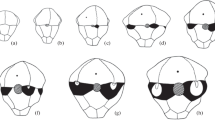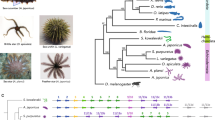Abstract
The variability of the location of the mouth along the theca in different genera of solutans indicates the presence of torsion in their ontogeny and is explained by a paedomorphic delay or overdevelopment of this process. The plane of change in the location of the mouth with the feeding appendage completely covering it corresponds to the larval plane. The flattening of the theca of most solutans is a secondary result of the transition to lying on the substrate. Larvae or young individuals of different taxa lay down on the substrate on their right or left side. This explains the opposite direction to the ground of adult animals of some taxa. Solutans branched off from the main stem of echinoderms before the origin of pentaradial symmetry, but after the appearance of torsion in their ontogeny. In their level of organization, they appear to be neither directly related to hemichordates, nor to be strongly modified Blastozoa. The appearance of the torsion in the ontogeny of echinoderms phylogenetically precedes the emergence of pentamerism but does not necessarily lead to it. The inversion of the anterior Hox-genes is a consequence, but not the cause, of torsion and pentamerism.








Similar content being viewed by others
Explore related subjects
Discover the latest articles and news from researchers in related subjects, suggested using machine learning.REFERENCES
Bassler, R.S. Pelmatozoa Palaeozoica (Generum et Genotyporum Index et Bibliographia), Fossilium Catalogus I Animalia, 1938, vol. 83, pp. 1–194.
Beklemishev, V.N., Osnovy sravnitel’noy anatomii bespozvonochnykh, Izd. 3, pererabotannoye i dopolnennoe (Fundamentals of Comparative Anatomy of Invertebrates, 3rd ed., Revised and Expanded), Moscow: Nauka, 1964, vols. 1–2.
Byrne, M., Martinez, P., and Morris, V., Evolution of a pentameral body plan was not linked to translocation of anterior Hox genes: The echinoderm HOX cluster revisited, Evol. Dev., 2016, pp. 1–7.https://doi.org/10.1111/ede.12172
Budd, G.E., Evolution: Mapping out early echinoderms, Current Biol., 2020, 30, R759–R782.https://doi.org/10.1016/j.cub.2020.05.013
Caster, K.E., Homoiostelea, in Treatise on Invertebrate Paleontology. Part S. Echinodermata, Moore, R.C., Ed., Lawrence, Kansas: Geol. Soc. Am. Univ. of Kansas, 1968, S581–S627.
Daley, P.E.J., The anatomy of the solute Girvanicystis batheri (?Chordata) from the Upper Ordovician of Scotland and a new species of Girvanicystis from the Upper Ordovician of South Wales, Zool. J. Linn. Soc., 1992, vol. 105, pp. 353–375. https://doi.org/10.1111/j.1096-3642.1992.tb01233.x
Daley, P.E.J., Anatomy, locomotion and ontogeny of the solute Castericystis vali from the Middle Cambrian of Utah, Geobios, 1995, vol. 28, no. 5, pp. 585–614. https://doi.org/10.1016/s0016-6995(95)80214-2
Daley, P.E.J., The first solute which is attached as an adult: a Mid-Cambrian fossil from Utah with echinoderm and chordate affinities, Zool. J. Linn. Soc., 1996, vol. 117, no. 4, 405–440. https://doi.org/10.1111/j.1096-3642.1996.tb01659.x
David, B., Lefebvre, B., Mooi, R., et Parsley, R.L., Are homalozoans echinoderms? An answer from the extraxial-axial theory, Paleobiology, 2000, vol. 26, pp. 529–555. https://doi.org/10.1666/0094-8373(2000)0262.0.CO;2
Deline, B., Thompson, J.R., Smith, N.S., et al., Evolution and development at the origin of a phylum, Curr. Biol., 2020, 30, no. 9, pp. 1672–1679.
Dzik, J., Evolutionary origin of asymmetry in early metazoan animals, in Advances in Biochirality, Palyi, G., Zucchi, C., and Caglioti, L., Eds., Amsterdam: Elsevier, 1999, pp. 153–190.
Friedrich, W.P., Systematik und Funktionsmorphologie mittelkam− brischer Cincta (Carpoidea, Echinodermata), Beringeria, 1993, vol. 7, pp. 3–190.
Haeckel, E., Generelle Morphologie der Organismen. Allgemeine Grundzuge der Organischen Formen-Wissenschaft, Mechanisch Begrundet Durch die von Charles Darwin Reformirte Descendenztheorie, Vol. 1: I–XXXII, 1–574, pls. I–II; Vol. 2: I–CLX, 1–462, pls. I–VIII, Berlin, Verlag von Georg Reimer, 1866.
Isaeva, V.V. and Rozhnov, S.V., Transformation of the ancestral body plan and axial growth in echinoderms: Ontogenetic and paleontological data, Paleontol. J., 2022, vol. 56, no. 8, pp. 1–24.
Ivanova-Kazas, O.M., Sravnitel’naya embriologiya bespozvonochnykh zhivotnykh. V 6-ti chastyakh. Chast’ 3. Iglokozhiye i polukhordovye (Comparative Embryology of Invertebrate Animals, in 6 vols. Vol. 3: Echinoderms and Hemichordates), Moscow: Nauka, 1978.
Jaekel, O., Ueber Carpoideen, eine neue Klasse von Pelmatozoen, Zeitschr. Deutsch. Geol. Gesellsch., 1901, 52, pp. 661–677.
Jaekel, O., Phylogenie und system der pelmatozoen, Paläontol. Zeitschr., 1918, vol. 3, no. 1, pp. 1, pp. 1–128.
Jefferies, R.P.S., The Ancestry of the Vertebrates, London: British Museum (Nat. Hist.), 1986.
Jefferies, R.P.S., The solute Dendrocystoides scoticus from the Upper Ordovician of Scotland and the ancestry of chordates and echinoderms, Palaeontology, 1990, vol. 33, pp. 631–679.
Lefebvre, B., Derstler, K., and Sumrall, C.D., A reinterpretation of the solutan Plasiacystis mobilis (Echinodermata) from the Middle Ordovician of Bohemia, in Echinoderm Research 2010: Proc. Seventh European Conf. on Echinoderms, Göttingen, Germany, October 2–9, 2010, Kroh, A. and Reich, M., Eds., Zoosymposia, 2012, no. 7, pp. 287–306.
Lefebvre, B. and Lerosey-Aubril, R., Laurentian origin of solutan echinoderms: new evidence from the Guzhangian (Cambrian Series 3) Weeks Formation of Utah, USA, Geol. Mag., 2018, vol. 155, no. 5, pp. 1190–1204. https://doi.org/10.1017/S0016756817000152
Li, Y., Omori, A., Flores, R.L., et al., Genomic insights of body plan transitions from bilateral to pentameral symmetry in Echinoderms, Comm. Biol., 2020, vol. 3. https://doi.org/10.1038/s42003-020-1091-1
Mooi, R. and David, B., Radial symmetry, the anterior/posterior axis, and echinoderm Hox genes. Ann. Rev. Ecol. Syst., 2008, vol. 39, pp. 43–62.
Nardin, E., Lefebvre, B., David, B., and Mooi, R., La radiation des échinodermes au Paléozoïque inférieur, l’exemple des blastozoaires, C. R. Palevol, 2009, vol. 8, nos. 2–3, pp. 179–188.https://doi.org/10.1016/j.crpv.2008.09.004
Noailles, F., Lefebvre, B., and Kašička, L., A probable case of heterochrony in the solutan Dendrocystites Barrande, 1887 (Echinodermata: Blastozoa) from the Upper Ordovician of the Prague Basin (Czech Republic) and a revision of the family Dendrocystitidae Bassler, 1938, Bull. Geosci., 2014, vol. 89, no. 3, pp. 451–476.
Lefebvre B., Guensburg T., Martin, E., et al., Exceptionally preserved soft parts in fossils from the Lower Ordovician of Morocco clarify stylophoran affinities within basal deuterostomes, Geobios, 2019, vol. 52, pp. 27–36.
Lefebvre, B. and Lerosey-Aubril, R., Laurentian origin of solutan echinoderms: new evidence from the Guzhangian (Cambrian Series 3) Weeks Formation of Utah, USA, Geol. Mag., 2018, vol. 155, vol. 5, pp. 1190–1204. https://doi.org/10.1017/S0016756817000152
Parsley, R.L., The echinoderm classes Stylophora and Homoiostelea: non Calcichordata, Paleontol. Soc. Pap., 1997, vol. 3, pp. 225–248.
Parsley, R.L., The Cincta (Homostelea) as blastozoans, in Echinoderm Research 1998, Candia Carnevali, M.D. and Bonasoro, F., Eds., Rotterdam: A.A. Balkema, 1999, pp. 369–375.
Parsley, R.L. and Caster, K.E., North American Soluta (Carpoidea, Echinodermata), Bull. Am. Paleontol., 1965, vol. 49, no. 221, pp. 109–174.
Parsley, R.L., Rozhnov, S.V., and Sumrall, C.D., Morphologic and systematic revision of the solute Manila estonica (Homoiostelea, Echinodermata) from the Upper Ordovician of Estonia, J. Paleontol., 2012, vol. 86, no. 3, pp. 462–469. https://doi.org/10.1666/11-083.1
Rahman, I.A. and Zamora, S., The oldest cinctan caproid (stem-group Echinodermata), and the evolution of the water vascular system, Zool. J. Linn. Soc., 2009, vol. 157, no. 2, pp. 420–432. https://doi.org/10.1111/j.1096-3642.2008.00517.x
Rozhnov, S.V., Crookedness of the stem and crown of pelmatozoan echinoderms as resulting from different kinds of heterochrony, in Echinoderm Res. 1998, Carnevali, M.D.C. and Bonasoro, F., Eds., Rotterdam: A.A. Balkema, 1998, pp. 385–390.
Rozhnov, S.V., Morphogenesis and evolution of crinoids and other pelmatozoan echinoderms in the Early Paleozoic, Paleontol. J., 2002, vol. 36, Suppl. 6, pp. S525–S674.
Rozhnov, S.V., Development of the trophic structure of Vendian and Early Paleozoic marine communities, Paleontol. J., 2009a, vol. 43, no. 11, pp. 1364–1367.
Rozhnov, S.V., The role of heterochrony in the establishment of body plan in higher echinoderm taxa, Biol. Bull., 2009b, vol. 36, no. 2, pp. 117–127.
Rozhnov, S.V., Combinatorial model for the formation of body plans in higher metazoan taxa: Paleontological insight, Paleontol. J., 2011, vol. 44, no. 12, pp. 1500–1508.
Rozhnov, S.V., The anteroposterior axis in echinoderms and displacement of the mouth in their phylogeny and ontogeny, Biol. Bull., 2012a, vol. 39, no. 2, pp. 162–171.
Rozhnov, S.V., Development of symmetry and asymmetry in the early evolution of the echinoderms, Paleontol. J., 2012b, vol. 46, no. 8, pp. 780–792.
Rozhnov, S.V., Symmetry of echinoderms: From initial bilaterally-asymmetric metamerism to pentaradiality, Nat. Sci., 2014, vol. 6, no. 4, pp. 171–183.https://doi.org/10.4236/ns.2014.64021
Rozhnov, S.V., The origin and homology of the jointed appendages of carpoid and pelmatozoan echinoderms, Invertebr. Zool., 2017, vol. 14, no. 2, pp. 174–181. https://doi.org/10.15298/invertzool.14.2.12
Rozhnov, S.V. and Jefferies, R.P.S., A new stem-chordate solute from the Middle Ordovician of Estonia, Geobios, 1996, vol. 29, pp. 91–109. https://doi.org/10.1016/S0016-6995(96)80074-x
Rozhnov, S.V. and Parsley, R.L., A new cornute (Homalozoa: Echinodermata) from the uppermost Middle Cambrian (Stage 3, Furongian) from Northern Iran: Its systematics and functional morphology, Paleontol. J., 2017, vol. 51, no. 5, pp. 500–509. https://doi.org/10.1134/S0031030117050100
Smith, A.B., The pre-radial history of echinoderms, Geol. J., 2005, vol. 40, pp. 255–280. https://doi.org/10.1002/gj.1018
Smith, A.B., Deuterostomes in a twist: the origins of a radical new body plan, Evol. Dev., 2008, vol. 10, pp. 493–503.https://doi.org/10.1111/j.1525-142X.2008.00260.x
Smith, A.B. and Zamora, S., Rooting phylogenies of problematic fossil taxa; a case study using cinctans (stem-group echinoderms), Palaeontology, 2009, vol. 52, pp. 803–821.https://doi.org/10.1111/j.1475-4983.2009.00880.x
Szabó, R. and Ferrier, D.E.K., Two more posterior Hox genes and Hox cluster dispersal in echinoderms, BMC Evol. Biol., 2018, vol. 18, no. 1, p. 203.https://doi.org/10.1186/s12862-018-1307-x
Tsuchimoto, J. and Yamaguchi, M., Hox expression in the direct-type developing sand dollar Peronella japonica, Dev. Dynam., 2014, vol. 243, no. 8, pp. 1020–1029. https://doi.org/10.1002/dvdy.24135
Zhang, X., Sun, L., Yaun, J., et al., The sea cucumber genome provides insights into morphological evolution and visceral regeneration, PLoS Biol, 2017, vol. 15, e2003790.
Zuykov, M.A., Terentiev, S.S., and Harper, D.A.T., New endemic brachiopod and echinoderm genera from the Upper Ordovician of the St Petersburg region, northwestern Russia, Geol. Fören. Stockholm Förhandl., 2008, vol. 130, pp. 87–93.
ACKNOWLEDGMENTS.
I am sincerely grateful to the reviewers V.V. Isaeva and G.A. Mirantsev for valuable comments, G.A. Anekeeva for help in preparing the drawings and discussion of this work. Special thanks to S.S. Terentiev for providing the previously unpublished drawings and reconstruction of the rhombiferan Fusicystis magnificus.
Author information
Authors and Affiliations
Corresponding author
Ethics declarations
The author declares that he has no conflict of interest.
Additional information
Translated by S. Nikolaeva
Rights and permissions
About this article
Cite this article
Rozhnov, S.V. Solutans (Echinoderms): Evolution Frozen between Torsion and Pentaradiality. Paleontol. J. 56, 1306–1321 (2022). https://doi.org/10.1134/S0031030122110144
Received:
Revised:
Accepted:
Published:
Issue Date:
DOI: https://doi.org/10.1134/S0031030122110144




